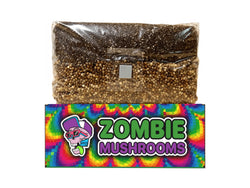Last Updated: April 26, 2025
-
Proper preparation and sterilization are your best defenses against contamination
-
Multiple inoculation methods suit different experience levels and goals
-
How long does it take for mycelium to colonize a jar? 10-30 days is typical
-
Which tool works well for inoculating a liquid culture? Sterile syringes with long needles
-
Regular monitoring of your inoculation jars ensures timely intervention if needed
-
G2G transfers allow efficient scaling as your skills develop
Why Grain Jars Are Essential for Mushroom Cultivation
Grain jars are the first important step in growing mushrooms successfully. These containers filled with nutrients give the mycelium the perfect place to grow strong before you move it to a larger growing area. It all starts with healthy grain jars that help you get a big mushroom harvest later on.
Grain jars work so well because:
-
They have lots of nutrients: Grains like rye, oats, and millet have plenty of food for the mycelium to grow.
-
They colonize quickly: Mycelium spreads fast through grain that's been prepared properly.
-
You can grow more: The colonized grain is easy to add to larger amounts of substrate to grow a lot of mushrooms.
Whether you want to grow tasty gourmet mushrooms or medicinal ones, learning how to inoculate grain jars is the first thing you need to do for consistent success.
Essential Tools for Grain Jar Inoculation
Before you start preparing your grain jar, get all the things you'll need so the process goes smoothly:
-
Wide-mouth mason jars (quart or half-pint size)
-
The grain you've chosen (rye, wheat, millet, oats, or wild bird seed)
-
Pressure cooker for sterilizing
-
Inoculation tools: spore syringes, liquid culture syringes, or colonized agar
-
70% isopropyl alcohol and disinfectant wipes
-
Breathable jar lids with filters
To keep things sterile, self-healing injection ports are a really good idea because they help keep contamination out. Many serious growers also use a still air box or laminar flow hood for extra protection, but beginners can do well without these special tools.
Choosing the Right Grain for Your Inoculation Jars
The type of grain you pick makes a big difference in how fast and how well the mycelium grows:
-
Rye is the most popular because it has good nutrition and soaks up water easily. It holds moisture evenly and gives the growing mycelium great access to nutrients.
-
Wheat is cheaper but you have to be careful with the water so it doesn't clump together.
-
Oats and millet let the mycelium grow more densely because they have more surface area, which can make the process faster.
-
Wild bird seed is a cheap option that colonizes quickly and is easy to find in most garden centers. Many people growing at home find this a great place to start.
Preparing Your Grain for Inoculation Jars
Getting your grain ready the right way is super important so no contamination happens. Follow these steps:
-
Soak your chosen grains in water for 12-24 hours. This softens the outside and starts them germinating. Adding a little gypsum at this point helps stop clumping.
-
Simmer the soaked grains for 20-30 minutes until they have the right amount of moisture – not too wet, not too dry.
-
Dry the grains on a clean towel until the water on the surface is gone. The grains should feel dry but still have moisture inside.
-
Fill your grain jars about 60-70% full, leaving room for shaking later, and then pressure cook them at 15 PSI for 90 minutes.
This longer sterilization time makes sure that any bad stuff that could cause contamination is gone before you add the mycelium. Doing this right really increases your chances of success.
Maintaining Sterility During Inoculation
Keeping contamination out is key to growing healthy mycelium in your grain jars:
-
Clean your work area really well with alcohol or Lysol before you start.
-
Wipe down all surfaces and spray the air to get rid of any airborne contaminants.
-
Wear clean gloves, a mask, and clothes that you've just washed.
-
Always heat your tools with a flame before you use them – heat your needle or scalpel until it's red-hot.
Many experienced growers think a still air box or laminar flow hood is really important for keeping things sterile when you're adding the mycelium, but you can still do well if you're careful even without these. Remember that most failures in growing come from contamination, so this step is really important.
Three Methods to Inoculate Your Grain Jars
1. Spore Syringe Method
The spore syringe method is the easiest way to start inoculating your grain jars, especially if you're new to this:
-
Shake the spore syringe well to spread the tiny spores evenly.
-
Heat the needle with a flame until it glows red, then let it cool down.
-
Stick the needle through the injection port and inject 1-2 mL of the spore solution.
-
Seal the grain jars tightly and keep them in the right conditions.
You should start to see the first signs of white mycelium growth in about 5-10 days, depending on the type of mushroom. This method takes some time, but it's the easiest way for beginners to get started.
2. Liquid Culture Method
Which tool works well for inoculating a liquid culture? A sterile syringe with a long needle is perfect for inoculating liquid culture. Using liquid culture makes the colonization much faster than using spore syringes because the mycelium is already actively growing in the liquid.
To use this method:
-
Shake the liquid culture syringe hard to break up the mycelium.
-
Heat the needle with a flame thoroughly.
-
Inject 1-2 mL into each grain jar through the injection port.
-
Keep them in the best conditions for fast growth.
The good thing about liquid culture is that you'll usually see growth within just 3-5 days, and the jar will often be fully colonized in 10-14 days – about half the time it takes with spore syringes.
3. Agar Transfer Method
For more experienced growers who want to choose the best genetics, the agar transfer method gives you the most control. This way, you can pick out the strongest, healthiest mycelium and only transfer that to your grain jars.
The process involves:
-
Using clean tools to cut small pieces of the agar that has mycelium growing on it.
-
Choosing the pieces that have the healthiest-looking mycelium.
-
Opening your prepared grain jars in a clean environment.
-
Placing the agar pieces directly onto the grain.
The mycelium will quickly grow from the agar onto the nutritious grain, starting colonization almost right away. Even though it's more technical, this method often gives you the most consistent results without contamination and is preferred by experienced growers.
Post-Inoculation: Incubation and Monitoring
How long does it take for mycelium to colonize a jar? Typically 10-30 days, depending on the mushroom type, the conditions, and how you inoculated it. During this important time:
-
Keep the temperature between 70-75°F (21-24°C) for the best growth.
-
Store the jars in the dark with a moderate amount of humidity.
-
Check them every day for any signs of contamination (unusual colors, smells, or growth).
-
When the mycelium has colonized about 30% of the jar, gently shake it to spread the growth points.
Shaking it helps the rest of the jar colonize much faster because it creates new places for the mycelium to grow. Be patient during this time – moving or handling the jars too much can hurt the delicate mycelium.
Using Fully Colonized Grain Spawn
Once your grain jars are completely filled with healthy white mycelium, you have a few options:
-
Transfer it to bulk substrates like coco coir, straw, or hardwood, depending on the type of mushroom you're growing. This is where all your work with the grain jar really pays off, as one jar can inoculate many pounds of substrate.
-
Do grain-to-grain transfers to make more spawn efficiently. With this method, you take a small amount of the colonized grain and put it into fresh, sterilized jars, allowing you to grow your cultivation capacity a lot.
-
Some types of mushrooms can even fruit directly from the grain jars under the right conditions, but you usually get a smaller harvest than if you use bulk substrates.
The fully colonized grain is the successful end of the first big part of growing mushrooms – a strong base for getting lots of mushrooms.
Common Mistakes and Solutions
Even experienced growers sometimes have problems with growing in grain jars:
-
Putting too much water in the grains makes them too wet, which encourages bacteria to grow.
-
Solution: Dry the grains properly before putting them in the jars – they should feel dry to the touch.
-
Not sterilizing properly leads to contamination often.
-
Solution: Make sure to pressure cook for the full 90 minutes at 15 PSI.
-
Shaking the jars too early can hurt the mycelium that's just starting to grow.
-
Solution: Wait until you see about 30% colonization before shaking.
-
The temperature changing too much can cause the growth to be inconsistent.
-
Solution: Keep a stable temperature between 70-75°F.
Paying attention to these common mistakes will really help you be more successful with growing in grain jars.
Scaling Up: Grain-to-Grain Transfers
Once you've successfully colonized your grain jars, you can grow even more by doing grain-to-grain (G2G) transfers:
-
Shake the fully colonized grain jars to break up the grains.
-
In a sterile environment, transfer 5-10 tablespoons of the colonized grain to fresh jars.
-
Gently shake the new jars to spread the inoculated grain throughout.
-
Keep them in the best conditions for fast colonization.
The great thing about this method is how efficient it is – one fully colonized jar can inoculate up to 10 new grain jars, creating a system that grows exponentially. G2G transfers also tend to colonize faster than other methods, often finishing in just 7-10 days because there are so many places for the mycelium to start growing in the jar.
Key Takeaways
Grain jars are the essential first step for growing mushrooms successfully. How well you prepare and inoculate them directly affects how big your harvest will be later on, so paying attention to the details in these early stages really pays off.
With practice and patience, what starts as a small hobby with a few grain jars can turn into a productive system that gives you pounds of fresh mushrooms.




